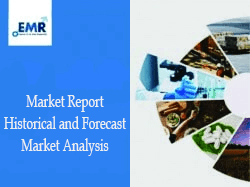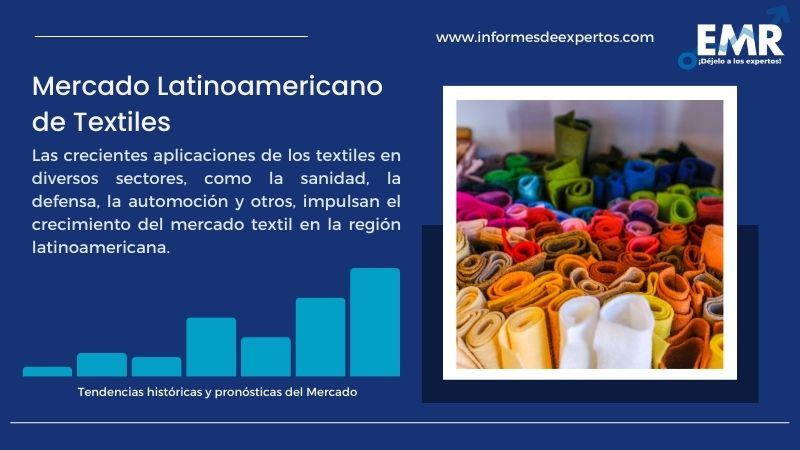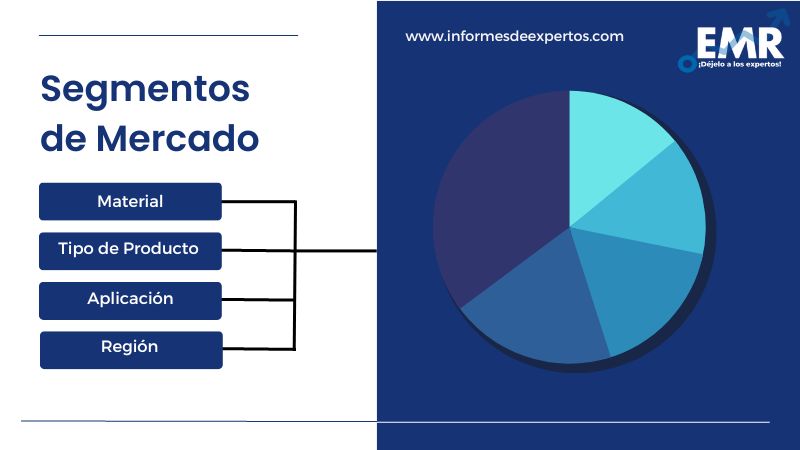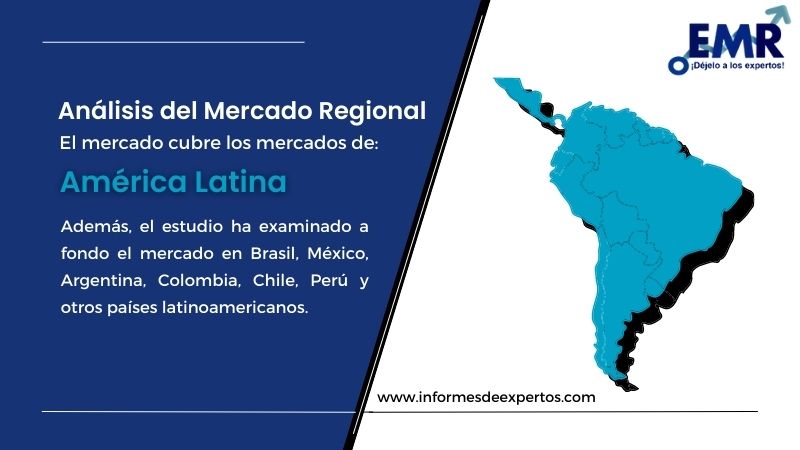Informes

Mercado Latinoamericano de Textiles – Por Material (Algodón, Químico, Lana, Seda, Otros); Por Tipo de Producto (Fibras Naturales, Poliéster, Nylon, Otros); Por Aplicación (Hogar, Técnico, Moda y Ropa, Otros); Por País (Brasil, México, Argentina y Otros); Dinámica del Mercado (2026-2035) y Panorama Competitivo
Perspectiva de la Industria Textil en América Latina
En 2025, el mercado latinoamericano de textiles alcanzó un valor aproximado de USD 79,27 mil millones. Se calcula que el mercado crecerá a una tasa anual compuesta del 3,2% entre 2026 y 2035, para alcanzar un valor de 104,79 mil millones de USD en 2035.

El textil se refiere a un tipo de tela o tejido producido mediante el uso de hilos, fibras y filamentos delgados de fuentes naturales, artificiales o combinadas. Hay ciertos textiles que exhiben propiedades, como alta resistencia a ácidos, álcalis, temperaturas y humedad. Debido a estas propiedades, los textiles se emplean ampliamente en la fabricación de prendas de vestir, materiales acolchados y aislantes, alfombras, filtros de aire y tejidos revestidos.
El mercado latinoamericano de textiles está aumentando a un ritmo robusto debido a la creciente demanda doméstica de productos textiles naturales y sostenibles, el crecimiento económico y el poder adquisitivo del consumidor. Además, las grandes aplicaciones de los textiles en diversas industrias como la salud, la defensa, el automóvil y otras contribuyen aún más al crecimiento del mercado. Otros factores como la creciente industria de moda y ropa, el aumento de los ingresos disponibles, la mayor popularidad de los textiles técnicos y el aumento de la población también impulsan la demanda de materiales.
Además, con los avances en las tecnologías inalámbricas, los desarrollos de nuevos productos como fibras ópticas, polímeros conductores y textiles inteligentes están ganando un tremendo impulso. Estos tejidos interactúan con el medio ambiente y reaccionan a estímulos físicos como fuentes térmicas, mecánicas, eléctricas y químicas. Se espera que estos avances tecnológicos creen una perspectiva positiva para la industria de textiles en general.
Textiles: Segmentación del Mercado

Según el material, el mercado se divide en:
- Algodón
- Químico
- Lana
- Seda
- Otros
Por la base del tipo de producto, la industria se segmenta en:
- Fibras Naturales
- Poliéster
- Nylon
- Otros
Por aplicación, el mercado de los textiles se divide en:
- Hogar
- Técnico
- Moda y Ropa
El segmento del hogar se segmenta en ropa de cama, cocina, tapicería, y toallas, entre otros. El segmento técnico se clasifica a su vez en construcción, transporte, protección, y medicina, entre otros. El segmento de moda y prendas de vestir se divide a su vez en prendas de vestir, corbatas y accesorios de vestir, y bolsos, entre otros.
Además, el estudio ha examinado a fondo el mercado en Brasil, México, Argentina y otros países latinoamericanos.

Rising Demand from Various Industries to Augment the Growth of the Latin America Textile Market
The escalating applications of textiles across various sectors such as healthcare, defence, automobiles, and others, drive the market growth of materials in the Latin American region. Moreover, the significant growth of the fashion and clothing industry also positively impacts the growth of the textiles industry. Nowadays, consumers are expecting better quality textiles along with high sustainable properties. This has led to the development of technical textiles with superior characteristics and features such as high technical performance, strength, and versatility, making them desirable for various commercial, domestic, and industrial uses, thus contributing significantly to the market’s growth. Over the forecast period, new product developments such as optical fibres, conductive polymers, and smart textiles are expected to expand the industry.
Actores Claves Mercado Latinoamericano de Textiles
Algunos de los principales actores mundiales son Anglés Textil S.A., Parkdale, Incorporated, Aztlan Textil SA de CV, Citosa Textiles SA de CV, CS Tech Contract Manufacturing, Novalan, S.A. de C.V., GRUPO, TEXTIL ALTEX, S.A. DE C.V., TURBO YARN SA DE CV, Enka De Colombia S.A., CI Creytex SA y Protela S.A entre otros.
Las bases de datos incluidas en el informe sobre el mercado latinoamericano de textiles proporcionan importantes impactos en el desarrollo presentadas por las principales empresas, teniendo en cuenta sus ingresos. Este informe consta de los valores del período histórico (2019-2025) y del período de pronóstico (2026-2035) con patrones de evaluación ampliados que se llevan a cabo mediante el análisis IDE basado en material, tipo de producto, aplicación y país del mercado para determinar el movimiento del estudio.
Además, el proyecto estudiado y analizado se basa en información detallada sobre el modelo de las cinco fuerzas de Porter, las estrategias de los principales actores existentes y sus carteras con diferenciación beneficiosa en innovación de productos en la industria. Por lo tanto, se concluye que el análisis del poder de negociación de los compradores, el poder adquisitivo de los consumidores, la amenaza de los sustitutos y la nueva entrada con el efecto de la reactivación económica y el desarrollo se evalúa para subrayar el poderoso impacto en el mercado.
Preguntas Clave Respondidas en Este Informe:
- ¿Cuál es el rendimiento actual y la trayectoria proyectada del mercado latinoamericano de textiles?
- ¿Cuáles son los principales impulsores, oportunidades y retos para el mercado latinoamericano de textiles?
- ¿Cómo afecta cada impulsor, restricción y oportunidad al mercado latinoamericano de textiles?
- ¿Cuáles son los principales mercados regionales estudiados en el informe?
- ¿Cuál es la región líder en el mercado latinoamericano de textiles?
- ¿Qué factores contribuyen al dominio de esta región en el mercado latinoamericano de textiles?
- ¿Cuál es la tasa de crecimiento histórica del mercado latinoamericano de textiles en los últimos años?
- ¿Cuáles son sus respectivas fortalezas y enfoques de mercado?
- ¿Cómo contribuyen estas empresas a la dinámica general del mercado latinoamericano de textiles?
- ¿Cuál es la estructura competitiva del mercado?
- ¿Quiénes son los principales actores del mercado latinoamericano de textiles?
Beneficios Clave para las Partes Interesadas:
- El informe de la industria de IDE ofrece un análisis cuantitativo exhaustivo de varios segmentos del mercado, las tendencias históricas y actuales del mercado, las previsiones del mercado y la dinámica del mercado latinoamericano de textiles de 2019 a 2035.
- El informe ofrece los datos más recientes sobre los impulsores, retos y oportunidades del mercado. El informe traza los principales mercados regionales, así como los que registran la tasa de crecimiento más rápida. Además, permite a las partes interesadas identificar los principales mercados nacionales de cada región.
- El análisis de las cinco fuerzas de Porter ayuda a las partes interesadas a evaluar el impacto de los nuevos operadores, la rivalidad competitiva, el poder del proveedor, el poder del comprador y la amenaza de sustitución. Ayuda a las partes interesadas a analizar el nivel de competencia en la industria de latinoamericano de textiles y su atractivo.
- El panorama competitivo permite a las partes interesadas comprender su entorno competitivo y ofrece una visión de las posiciones actuales de los principales actores del mercado.
Alcance del Mercado:
|
Características del Informe |
Detalles |
|
Año Base de la Estimación: |
2025 |
|
Datos Históricos: |
2019-2025 |
|
Datos de Pronóstico: |
2026-2035 |
|
Alcance del Informe: |
Tendencias Históricas y Previsiones del Mercado, Impulsores y Limitantes de
|
|
Desglose por Material: |
|
|
Desglose por |
|
|
Desglose por Aplicación: |
|
|
Desglose por País: |
|
|
Dinámica del Mercado: |
|
|
Panorama Competitivo: |
|
|
Empresas Cubrietas: |
|
*En Informes de Expertos siempre nos esforzamos por brindarle la información más reciente. Los números de artículo son solo indicativos y pueden diferir del informe real.
Language of the Report – English
Sin embargo, el informe puede estar disponible en español por un costo adicional.
1 Preface
2 Report Coverage – Key Segmentation and Scope
3 Report Description
3.1 Market Definition and Outlook
3.2 Properties and Applications
3.3 Market Analysis
3.4 Key Players
4 Key Assumptions
5 Executive Summary
5.1 Overview
5.2 Key Drivers
5.3 Key Developments
5.4 Competitive Structure
5.5 Key Industrial Trends
6 Market Snapshot
7 Opportunities and Challenges in the Market
8 Global Textile Market Overview
8.1 Key Industry Highlights
8.2 Global Textile Historical Market (2019-2025)
8.3 Global Textile Market Forecast (2026-2035)
8.4 Global Textile Market Share by Region
8.4.1 North America
8.4.2 Europe
8.4.3 Asia Pacific
8.4.4 Latin America
8.4.5 Middle East and Africa
9 Latin America Textile Market Overview
9.1 Key Industry Highlights
9.2 Latin America Textile Historical Market (2019-2025)
9.3 Latin America Textile Market Forecast (2026-2035)
10 Latin America Textile Market by Material
10.1 Cotton
10.1.1 Historical Trend (2019-2025)
10.1.2 Forecast Trend (2026-2035)
10.2 Chemical
10.2.1 Historical Trend (2019-2025)
10.2.2 Forecast Trend (2026-2035)
10.3 Wool
10.3.1 Historical Trend (2019-2025)
10.3.2 Forecast Trend (2026-2035)
10.4 Silk
10.4.1 Historical Trend (2019-2025)
10.4.2 Forecast Trend (2026-2035)
10.5 Others
11 Latin America Textile Market by Product Type
11.1 Natural Fibers
11.1.1 Historical Trend (2019-2025)
11.1.2 Forecast Trend (2026-2035)
11.2 Polyester
11.2.1 Historical Trend (2019-2025)
11.2.2 Forecast Trend (2026-2035)
11.3 Nylon
11.3.1 Historical Trend (2019-2025)
11.3.2 Forecast Trend (2026-2035)
11.4 Others
12 Latin America Textile Market by Application
12.1 Household
12.1.1 Historical Trend (2019-2025)
12.1.2 Forecast Trend (2026-2035)
12.1.3 Breakup by Type
12.1.3.1 Bedding
12.1.3.2 Kitchen
12.1.3.3 Upholstery
12.1.3.4 Towel
12.1.3.5 Others
12.2 Technical
12.2.1 Historical Trend (2019-2025)
12.2.2 Forecast Trend (2026-2035)
12.2.3 Breakup by Type
12.2.3.1 Construction
12.2.3.2 Transport
12.2.3.3 Protective
12.2.3.4 Medical
12.2.3.5 Others
12.3 Fashion and Clothing
12.3.1 Historical Trend (2019-2025)
12.3.2 Forecast Trend (2026-2035)
12.3.3 Breakup by Type
12.3.3.1 Apparel
12.3.3.2 Ties and Clothing Accessories
12.3.3.3 Handbags
12.3.3.4 Others
12.4 Others
13 Latin America Textile Market by Country
13.1 Brazil
13.1.1 Historical Trend (2019-2025)
13.1.2 Forecast Trend (2026-2035)
13.2 Mexico
13.2.1 Historical Trend (2019-2025)
13.2.2 Forecast Trend (2026-2035)
13.3 Argentina
13.3.1 Historical Trend (2019-2025)
13.3.2 Forecast Trend (2026-2035)
13.4 Others
14 Market Dynamics
14.1 SWOT Analysis
14.1.1 Strengths
14.1.2 Weaknesses
14.1.3 Opportunities
14.1.4 Threats
14.2 Porter’s Five Forces Analysis
14.2.1 Supplier’s Power
14.2.2 Buyer’s Power
14.2.3 Threat of New Entrants
14.2.4 Degree of Rivalry
14.2.5 Threat of Substitutes
14.3 Key Indicators of Demand
14.4 Key Indicators of Price
15 Competitive Landscape
15.1 Market Structure
15.2 Company Profiles
15.2.1 Anglés Textil S.A.
15.2.1.1 Company Overview
15.2.1.2 Product Portfolio
15.2.1.3 Demographic Reach and Achievements
15.2.1.4 Certifications
15.2.2 Parkdale, Incorporated
15.2.2.1 Company Overview
15.2.2.2 Product Portfolio
15.2.2.3 Demographic Reach and Achievements
15.2.2.4 Certifications
15.2.3 Aztlan Textil SA de CV
15.2.3.1 Company Overview
15.2.3.2 Product Portfolio
15.2.3.3 Demographic Reach and Achievements
15.2.3.4 Certifications
15.2.4 Citosa Textiles SA de CV
15.2.4.1 Company Overview
15.2.4.2 Product Portfolio
15.2.4.3 Demographic Reach and Achievements
15.2.4.4 Certifications
15.2.5 CS Tech Contract Manufacturing
15.2.5.1 Company Overview
15.2.5.2 Product Portfolio
15.2.5.3 Demographic Reach and Achievements
15.2.5.4 Certifications
15.2.6 Novalan, S.A. de C.V.
15.2.6.1 Company Overview
15.2.6.2 Product Portfolio
15.2.6.3 Demographic Reach and Achievements
15.2.6.4 Certifications
15.2.7 GRUPO TEXTIL ALTEX, S.A. DE C.V.
15.2.7.1 Company Overview
15.2.7.2 Product Portfolio
15.2.7.3 Demographic Reach and Achievements
15.2.7.4 Certifications
15.2.8 TURBO YARN SA DE CV
15.2.8.1 Company Overview
15.2.8.2 Product Portfolio
15.2.8.3 Demographic Reach and Achievements
15.2.8.4 Certifications
15.2.9 Enka De Colombia S.A.
15.2.9.1 Company Overview
15.2.9.2 Product Portfolio
15.2.9.3 Demographic Reach and Achievements
15.2.9.4 Certifications
15.2.10 CI Creytex SA
15.2.10.1 Company Overview
15.2.10.2 Product Portfolio
15.2.10.3 Demographic Reach and Achievements
15.2.10.4 Certifications
15.2.11 Protela S.A
15.2.11.1 Company Overview
15.2.11.2 Product Portfolio
15.2.11.3 Demographic Reach and Achievements
15.2.11.4 Certifications
15.2.12 Others
16 Key Trends and Developments in the Market
List of Key Figures and Tables
1. Global Textile Market: Key Industry Highlights, 2019 and 2035
2. Latin America Textile Market: Key Industry Highlights, 2019 and 2035
3. Latin America Textile Historical Market: Breakup by Material (USD Million), 2019-2025
4. Latin America Textile Market Forecast: Breakup by Material (USD Million), 2026-2035
5. Latin America Textile Historical Market: Breakup by Product Type (USD Million), 2019-2025
6. Latin America Textile Market Forecast: Breakup by Product Type (USD Million), 2026-2035
7. Latin America Textile Historical Market: Breakup by Application (USD Million), 2019-2025
8. Latin America Textile Market Forecast: Breakup by Application (USD Million), 2026-2035
9. Latin America Textile Historical Market: Breakup by Country (USD Million), 2019-2025
10. Latin America Textile Market Forecast: Breakup by Country (USD Million), 2026-2035
11. Latin America Textile Market Structure
*The list of players in the competitive landscape section can be customised or made more exhaustive based on your specific requirements.*
¿Cuál fue el valor de la industria textil en América Latina en 2025?
El mercado de textiles de América Latina alcanzó un valor medio de USD 79,27 mil millones en 2025.
¿Cuál es la CAGR del mercado latinoamericano de textiles en el periodo de pronóstico 2026-2035?
Se prevé que el mercado latinoamericano de textiles crezca a una CAGR del 3,2% en el periodo de pronóstico 2026-2035.
¿Cuáles son los factores que impulsan el crecimiento del mercado textil en América Latina?
El aumento de las aplicaciones textiles en diversos sectores, como la sanidad, la defensa, la automoción y el crecimiento de la industria de la moda son los principales factores que impulsan el crecimiento del mercado latinoamericano de textiles.
¿Cuáles son los distintos materiales utilizados en la industria textil?
Hay varios materiales utilizados en la industria textil, como algodón, productos químicos, lana y seda, entre otros.
¿Cómo se segmenta el mercado textil en función de las aplicaciones?
En función de las aplicaciones, el mercado textil se segmenta en hogar, técnico, moda, y ropa, entre otros.
¿Quiénes son los principales actores de la industria textil en América Latina?
Los principales actores del mercado textil en América Latina son Anglés Textil S.A., Parkdale, Incorporated, Aztlan Textil SA de CV, Citosa Textiles SA de CV, CS Tech Contract Manufacturing, Novalan, S.A. de C.V., GRUPO TEXTIL ALTEX, S.A. DE C.V., TURBO YARN SA DE CV, Enka De Colombia S.A., CI Creytex SA, y Protela S.A, entre otrs.
¿Cuál es la fibra más comúnmente preferida?
La fibra natural es la fibra más comúnmente preferida debido a su origen ecológico y al hecho de que es menos perjudicial para los animales y la naturaleza.
¿Cuáles son las principales regiones incluidas en el informe del mercado latinoamericano de textiles?
Las principales regiones incluidas en el informe del mercado latinoamericano de textiles son Brasil, México, y Argentina, entre otras.
¿Cuál es la perspectiva de pronóstico del mercado latinoamericano de textiles para 2026-2035?
Se espera que el mercado latinoamericano de textiles experimente un fuerte crecimiento durante el periodo de previsión de 2026-2035 para alcanzar los USD 104,79 mil millones en 2035.
Excel Data Set
USD1799
-
Datos completos en formato Excel para un usuario
-
Impresión no permitida
-
Entrega por Email
-
Personalización limitada gratuita (pre-venta)Soporte de analista post ventaDescuento del 50% en la Próxima ActualizaciónUsuario Único
USD3199
USD2999-
Restringido a un usuario
-
Solo una impresión
-
Disponible en PDF
-
Personalización limitada gratuita (pre-venta)Soporte de analista post ventaDescuento del 50% en la Próxima ActualizaciónCinco Usuarios
USD4199
USD3999-
Restringido a cinco usuarios
-
Una impresión por usuario
-
Disponible en PDF
-
Personalización limitada gratuita (pre-venta)
-
Soporte de analista post venta
-
Descuento del 50% en la Próxima Actualización
Multiusuario
USD5199
USD4999-
Usuarios ilimitados dentro de la organización
-
Impresiones ilimitadas
-
Disponible en PDF
-
Personalización limitada gratuita (pre-venta)
-
Soporte de analista post venta
-
Descuento del 50% en la Próxima Actualización
Póngase en Contacto¿Cualquier Pregunta? Hable con un Analista
Solicitar una MuestraVer una Muestra
Solicitar PersonalizaciónSe le olvidó algo? Pregunte Ahora
¿Por qué Informes de Expertos?La Gente Adecuada
Somos técnicamente excelentes, estratégicos, prácticos, experimentados y eficientes; nuestros analistas son cuidadosamente seleccionados en función de tener los atributos correctos para trabajar con éxito y ejecutar proyectos basados en sus expectativas.
Metodología Correcta
Aprovechamos nuestra tecnología de vanguardia, nuestro acceso a bases de datos confiables y nuestro conocimiento de los modelos actuales utilizados en el mercado para ofrecerle soluciones de investigación que se adapten a sus necesidades y lo pongan a la vanguardia.
Precio Justo
Realizamos una investigación exhaustiva y de calidad superior a precios razonables, inigualables y que demuestran nuestra comprensión de su estructura de recursos. Además, ofrecemos descuentos atractivos en nuestros próximos informes.
Apoyo Adecuado
Nuestro equipo de analistas expertos está a su disposición entera para ofrecerle resultados óptimos personalizados para satisfacer sus necesidades precisas dentro del plazo especificado y ayudarlo a comprender mejor la industria.
Informes SimilaresEl mercado de metales básicos de América Latina está experimentando un crecimiento significativo principalmente por la creciente demanda de la industria de la construcción, el auge del sector de l...
El mercado textil en Brasil está experimentando un crecimiento significativo debido a la expansión de las plataformas de comercio electrónico, el auge de la industria de la moda, el crecimiento de ...
Las actualizaciones tecnológicas, las prácticas agrícolas sostenibles y la expansión de las aplicaciones a base de algodón están impulsando la demanda.
El tamaño del mercado textil en México está expandiendo debido a la rápida urbanización y al crecimiento de la población, al aumento de la aplicación en la industria automotriz, y la creciente ...
El mercado de textiles en colombia está registrando un crecimiento significativo debido a la creciente demanda de diversas industrias de uso final, como la automoción, la sanidad y la moda, y junto ...
Newsletter





